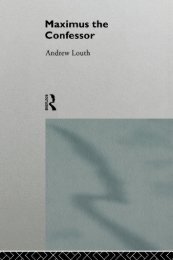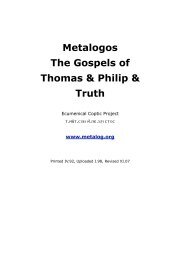Gospels of Thomas and Philip and Truth - Syriac Christian Church
Gospels of Thomas and Philip and Truth - Syriac Christian Church
Gospels of Thomas and Philip and Truth - Syriac Christian Church
Create successful ePaper yourself
Turn your PDF publications into a flip-book with our unique Google optimized e-Paper software.
Barnabas, the Shepherd <strong>of</strong> Hermas, the Gospel <strong>of</strong> the Egyptians, the<br />
Gospel <strong>of</strong> the Hebrews (in which Christ calls the Sacred Spirit his Mother),<br />
the Traditions <strong>of</strong> Matthias, the Apocalypse <strong>of</strong> Peter, the Didakhê, <strong>and</strong> the<br />
Acts <strong>of</strong> Paul. Thus the Codex Sinaiticus <strong>of</strong> the mid-4th century includes<br />
both Barnabas <strong>and</strong> the Shepherd <strong>of</strong> Hermas, while the Codex<br />
Alex<strong>and</strong>rinus <strong>of</strong> the early 5th century contains I <strong>and</strong> II Clement as well as<br />
the Psalms <strong>of</strong> Solomon. There was no church council regarding the NT<br />
canon until the Synod <strong>of</strong> Laodicea (363 AD), which indeed rejected John's<br />
Apocalypse or Book <strong>of</strong> Revelation. Twelve centuries later (!), the Western<br />
Canon was finally settled by the Council <strong>of</strong> Trent (1546 AD), which<br />
designated the present 27-book listing as an article <strong>of</strong> Roman Catholic<br />
faith (although episcopal councils have never claimed to be infallible; the<br />
vote at Trent was 24 to 15, with 16 abstentions)— <strong>and</strong> which the various<br />
Protestant <strong>Church</strong>es subsequently accepted. The sundry Eastern<br />
<strong>Church</strong>es have equally complex records on establishing their respective<br />
NT canons: thus, the Armenian canon includes a Pauline III Corinthians;<br />
the Coptic NT contains I+II Clement; the Syrian/ Nestorian Peshitta<br />
excludes II+III John, Jude, <strong>and</strong> Rev/Ap; the Ethiopian Bible adds books<br />
called the Sínodos, the Epistle <strong>of</strong> Peter to Clement, the Book <strong>of</strong> the<br />
Covenant, <strong>and</strong> the Didascalia; <strong>and</strong> John's Rev/Ap is still not included in<br />
the Greek Orthodox Bible! (see Biblio.35)<br />
Notably, however, the <strong>Gospels</strong> <strong>of</strong> <strong>Thomas</strong>, <strong>Philip</strong> <strong>and</strong> <strong>Truth</strong> were<br />
evidently not known to any <strong>of</strong> those traditions at the time <strong>of</strong> their<br />
attempts at establishing a NT canon, never being so much as mentioned<br />
in their protracted deliberations— <strong>and</strong> hence were never even under<br />
consideration for inclusion in their respective listings. In any case, the<br />
concept <strong>of</strong> a canon was certainly never intended to exclude the possible<br />
inspiration <strong>of</strong> any subsequent textual discoveries or isolated agrapha (Lk<br />
1:1, Jn 21:25).<br />
Precisely what transpired during the first 3½ centuries AD, prior to the<br />
earliest ecclesiastical attempts at forming a canon, is notoriously obscure,<br />
6




